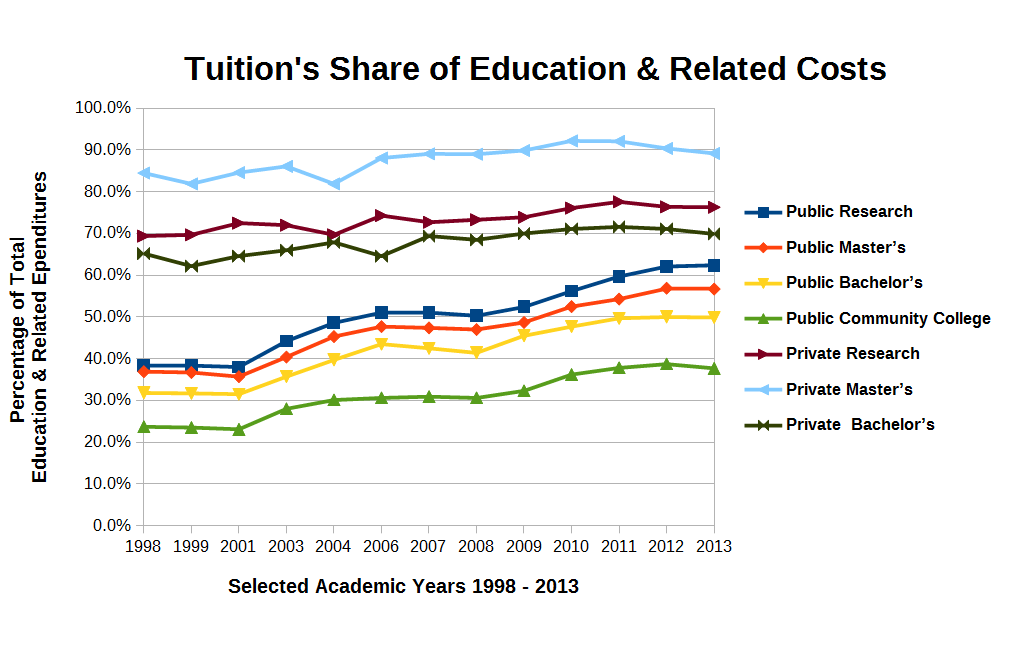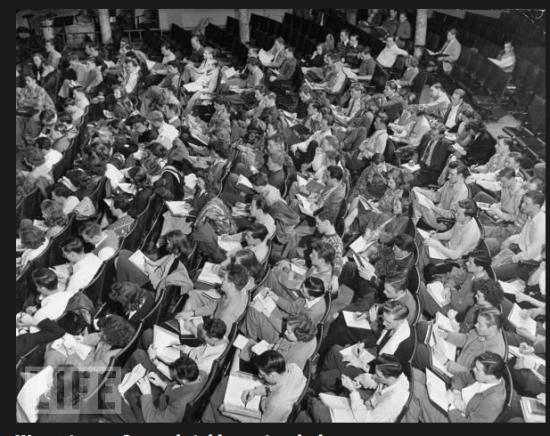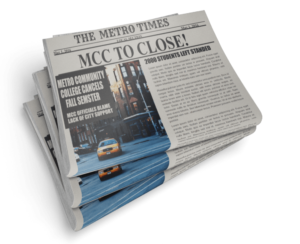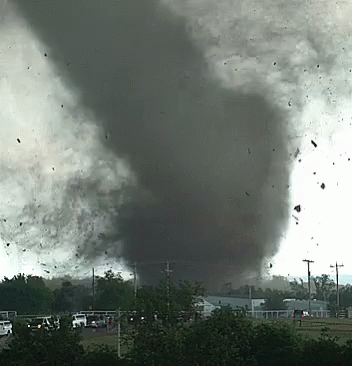 For some in American higher education, the headline College enrollments to double in next decade that appeared in the July 12, 2016, edition of Education DIVE, a daily online newsletter of news from all aspects of education, may have seemed like the message from on high that they desperately wanted to see and hear. However, if American Institutions of Higher Education (IHEs) are counting on this touted coming influx of students for the future health of their institutions, they are going to be sadly mistaken.
For some in American higher education, the headline College enrollments to double in next decade that appeared in the July 12, 2016, edition of Education DIVE, a daily online newsletter of news from all aspects of education, may have seemed like the message from on high that they desperately wanted to see and hear. However, if American Institutions of Higher Education (IHEs) are counting on this touted coming influx of students for the future health of their institutions, they are going to be sadly mistaken.
This installment is the fifth part in a series on the economic conditions in American higher education. The preceding installment, The Business Model of All of Higher Education is Broken: Part IV — Tuition and Fees, dealt with the general trend of increasing the share that tuition must cover of an institution’s Education and Related Costs (E & R Costs). However, in The Business Model of All of Higher Education is Broken: Part III — Tuition and Fees, we saw that students and their families are resisting any and all suggestions that increasing individual students’ tuition and fees should provide a possible solution to higher education’s financial difficulties. Students and families are saying, “Enough is enough! We’ve paid our fair share!” This thought is only reinforced by politicians saying that four years of public college education should be free for every one or at least the overwhelming majority of the American public. This means that to realistically get more money out of the Tuition & Fees Bucket, institutions must increase the number of students paying the current or possibly even lower tuition charges. If institutions are counting on many new students saving them from financial disaster, there are several significant holes in this strategy.

In spite of the bold headline, the first hole in this strategy is what I believe is the mistaken belief of many leaders in the American higher education megaplex that there is a seemingly unending and ever expanding supply of students who will pay any price to be part of the American higher education scene. The preceding post in this series presented some of the arguments against raising tuition. Two recent articles in education press circles clearly show the strategy of counting on continuously growing enrollments may soon blow up in the face of traditional IHEs. While the Education DIVE headline appears to bolster the claim that there is a growing supply of fresh bodies for American IHEs, it conveniently omitted the fact that the article was referring to “the number of students in colleges and universities across the globe will double by 2025.” As you read the article, it does admit that enrollments at U.S. colleges are falling. Are they trying to rain on the parade of educational expansionists?
In the Nineteenth Century, the history of college enrollments in the United States had been one of relatively consistent, but slow growth. The rate of growth increased slightly for the first half of the Twentieth-Century, before taking off like a rocket ship in the latter half of the Twentieth-Century. In the early years of the Twenty-First Century, the growth has sputtered and even dropped for several years. This is the context for the statement in the Education DIVE concerning falling enrollments. The article references the CNN report College enrollment is dropping. Bad sign? This article begins by pointing out that college enrollment in the United States “peaked in 2010 at just over 21 million students. Attendance has dropped every year since. By the fall of 2014 — the most recent year that government data is available from the Digest of Educational Statistics published by the National Center for Educational Statistics–there were 812,069 fewer students walking around college campuses.” Is this the first sign of trouble on the horizon? I think that it is a clear warning sign and should be taken very seriously by American IHEs.
However, the CNN article tries to assuage fears of impending doom by suggesting that this decline is primarily due to improvement in the economy. “More people are going back to work instead of signing up for additional degrees. ‘Historically, as the economy improves and Americans get back to work, college enrollment declines,’ says U.S. Under Secretary of Education Ted Mitchell.” The unemployment rates from the Bureau of Labor Statistics lend some credence to this explanation, since the unemployment rate in 2010 was almost twice the unemployment in 2014. However, current federal and state administrations predict continued low unemployment rates, while predicting and pushing more students into higher education. Are IHEs and the federal and local governments trying to “have their cake and eat it too?”
Chart 1 below presents Total U.S. College Enrollments and Projections from 1870 to 2025. The data has been extracted from several sources including the report, 120 Years of American Education: A Statistical Portrait, published by the National Center for Educational Statistics (NCES), and the 2016 Digest of Educational Statistics also published by NCES. This graph gives the reader the sense of the enormity of the growth of American higher education in the last century compared to its early days.

However, because of the scale of the graph, it is difficult to get a perspective on some of the early growth of American higher education. Thus in Chart 2, I emphasize the growth of enrollment in the years 1870 to 1920.

Is the headline claim of enrollment doubling totally unreasonable? In the history of U.S. higher education, doubling of enrollment within one decade has never happened. The closest occurred from 1870, when the first doubling of enrollment took just over a decade. The next doubling of enrollments took approximately two decades. Looking at both Charts 1 and 2, we see that the next six doublings of enrollment took approximately 15 years each. Then in 1980, the brakes on enrollment growth began to slow down growth considerably. If there were to be another doubling of enrollment the NCES projections predict that it would take approximately five decades.
Evan Schofer and John W. Meyer in their paper The World-Wide Expansion of Higher Education in the Twentieth-Century present some very startling results. They show that even though the higher education enrollments in the United States were expanding at what seemed to be break-neck speed in the last half of the Twentieth-Century, the United States’ share of the world’s higher education market fell from 50% to a meager 20%. With no apparent let-up in world-wide higher education enrollments, at least in the analysis of UNESCO and the independent scholars, Schofer and Meyer, it is a very small leap of faith to postulate that they could easily top 250 million by 2025. This would mean that the U.S. share of the world market falls to approximately 10%. The United States is no longer the top dog. The two countries of China and India have surpassed the U.S. share of the world market, with Europe, Africa and Latin America nipping at its heels.
I don’t believe that the future is much brighter for U.S. higher Education. This is especially true if U.S. colleges stick to their well-ingrained bias of focusing their offerings in a full-time, face-to-face format to late adolescents. This population has peaked in the United States and will be in decline over the next 20 years as the following chart from the U.S. Census Bureau indicates.
Enrollment peaked in 2011. In July of 2011, there were about 18.1 million people in the prime college years of 18-21. In June of 2014, that number was down to 17.4 million – nearly 700,000 fewer young people. U.S. colleges enrolling 300,000 fewer students last year suddenly makes a lot of sense. Not only are other options opening up for high school grads, but there are also just fewer warm bodies to go around.If we think about the graduating high school seniors who might be entering college, there would have been close to 4.6 million 18 year-olds in 2009. Five years later, there were only 4.2 million – And the 17 year-olds preparing for college are the smallest age cohort younger than 35 – at 4,176,000. The next set of them (current 16 year-olds) will be even smaller. In fact, we should expect a slowly declining pool of college-aged students for the foreseeable future, as illustrated by the graph below.

This has not been a very upbeat posting. My next post will attempt to analyze the problems and difficulties facing the U.S. higher education system. I will then propose some possible solutions. I can’t guarantee that the proposed solutions will work. In fact, the only thing that I can guarantee is that some of my readers will find these proposed solutions completely untenable.


























